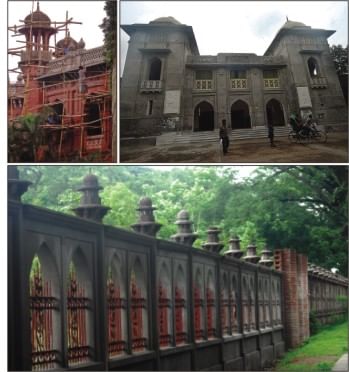Mindless repair damages forms and features of historic buildings at DU

Top left, file photo of repair work at Curzon Hall, and, Top right, a renovated building of the SM Hall and above, a portion of the wall of SM Hall.Photo: STAR
Authorities of Dhaka University (DU) have allegedly damaged the architectural features of historic buildings like Curzon Hall while repairing and renovating them.
Experts said without thinking about proper documentation and conservation of the buildings, the authorities have caused damages to the originality of forms, features and construction materials through alteration and changes.
Moreover, the buildings of colonial era are being repaired without on-site involvement of experts, said eminent architects and historians.
The university authorities undertook 'repair and maintenance' work of Curzon Hall, SM (Salimullah Muslim) Hall and FH (Fazlul Huq) Hall more than a year back. Masons and labourers of hired contractors are carrying out the intricate job of recreating.
On a number of visits to Curzon Hall, masons were found reconstructing the decayed kiosks and omla kalasha (pitcher-like) ornamentation on their own.
According to experts, repair of such historic buildings must have been based on proper scientific documentation and carried out under intimate supervision of experts.
Dr M Shahidul Ameen, a professor of architecture at Bangladesh University of Engineering and Technology (Buet), who also a member of DU's repair committee, said that masons have altered the original style and features of Curzon Hall in many instances.
“I wrote to all the committee members including the vice-chancellor of the university in October last and said that Curzon Hall requires comprehensive conservation,” he said. “We must conserve the building with the help of engineers and architects.”
He alleged that the university authorities have engaged an inept contractor in the work who has made many mistakes in the way of doing repair.
“Many decorative features have already been damaged,” he said. “Authorities have even set up toilets on the terrace of the building releasing waste water on the roof.”
Conservationist architect Abu Sayeed M Ahmed said that experts on conservation and heritage should have been involved with the renovation work of Curzon Hall and SM Hall. But the university authorities appear to have no overall conservation plan.
The DU authorities have already disfigured the Curzon Hall creating a number of compartments on the ground floor closing open arcades and corridors.
The masons at work told this correspondent that they have reconstructed the damaged cupolas, kiosks and kalasha ornamentation (pinnacles) of Curzon Hall on their own. They have used cement and sand instead of original lime and surki (brick dust).
Cement and sand have also been used in reconstruction of the north barrack of Fazlul Huq Hall demolishing the old structure under a Tk 1.65 crore project. RCC (reinforced cement concrete) has been used in this building replacing the original brick roof.
According to Abu Sayeed, Curzon Hall, SM Hall, FH Hall and Dhaka Medical College building are all edifices that bear testimony to an architectural trend with a blend of colonial and Islamic influence. The blend of two styles developed a new form of distinct local architecture in this part of Bengal.
This form of architecture was in practice until 1950s. Classical features like magnificently imposing central access, symmetrical (wings) buildings on two sides of the central access and freestanding columns as used in Curzon Hall were introduced in the local architectural pattern through colonial architectural practice, he said.
Regarding SM Hall, Abu Sayeed said the original boundary wall was in a good condition and had an eye-level height to facilitate a full view of the Hall. But the new wall is so high that it resembles with a prison boundary. “Knocking down the original wall and bringing change to its design is a major deviation,” he said.
Prof Muntassir Mamoon, who has extensively worked on Dhaka's history, said that Curzon Hall came into being in the way of Dhaka's being the new capital of divided British Bengal in 1905. It became a centre spot of establishment of Dhaka University.
Significance of Curzon Hall lies in the fact that it symbolises not only Dhaka University but Dhaka city as a whole, he said.
Prof AH Ahmed Kamal, chairman of DU's history department, said his department has no representation in the repair committee on Curzon Hall.
DU Vice-chancellor SMA Faiz said Curzon Hall had long been treated in a bad way in the past spoiling its grandeur and features. But nobody raised any voice then. “We are facing criticism when we are trying to repair it with utmost care.”
He said that the authorities have involved the Department of Archaeology (DoA) and experts from Buet (including Dr Ameen) in the repair work.
“Carrying out a comprehensive conservation work needs huge amount of money,” the VC said. “But we will never get the resource required for such work. On the other hand, we might lose the available fund had we not undertaken the repair work.”
Temporary repair implies not only damage to the uniqueness of these historic edifices but waste of public money in a recurrent cycle, said competent sources.
Md Shafiqul Alam, director of DoA, said his department was invited to be involved in the work only four to five months back and by that time repair work had already progressed far. In the beginning, the department used to give only advice at committee meeting.
“A major compromise has occurred with repair materials for Curzon Hall,” he said.
“Though it should have been mortar (mixture) of lime and brick dust, as it originally was, they have used cement and sand to repair decayed portions of the building.”
“Original form and shape of architectural features of Curzon Hall have been altered in the way of repeated repair work,” he said.
He said that they stopped applying extra colour on the Curzon Hal, as it was different from the original natural brick colour.
Earlier, an asymmetrical building of Applied Physics Department was constructed as an odd feature to the grand and aesthetic landscape of Curzon Hall.
The Building Construction Rules of 2007 provide for careful and controlled intervention on the important old buildings.

 For all latest news, follow The Daily Star's Google News channel.
For all latest news, follow The Daily Star's Google News channel. 



Comments